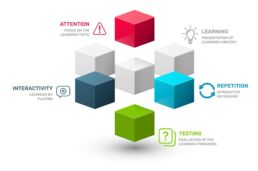Microlearning
Microlearning: Small learning content, big effect
Learning in small bites is currently one of the most popular e-learning trends. True to the motto “Micro is the approach, big is the learning success”, we explain what distinguishes microlearning.
No matter which ranking you consult: Microlearning always occupies one of the top positions in the hit lists of current e-learning trends. No wonder, it is an insanely effective method to convey learning content in a sustainable way. In e-didactics, this basically means learning by means of small learning packages(learning nuggets) or learning in short learning units. The aim is to achieve a learning goal as independently of time and place as possible and with little effort. Even if this sounds too good to be true at first, well-done and skillfully used microlearning can actually ensure better learning success than conventional training. In order for this microlearning effect to actually occur, however, a few prerequisites must be met. We’ll take a closer look at what these are in the following section.
When microlearning makes sense
Let’s now take a look at when learning in chunks makes sense and improves learning success. Microlearning makes sense …
… for clearly defined subject areas.
The use of tidbits of learning makes sense when the topic is a definable one. After all, not every topic is suitable for being broken down into small bites. For example, if the content is complex instructions or products, it makes little sense to take content out of context and make small packages out of it. Before you start filleting a topic, you have to ask yourself if it makes sense in chunks. Safety briefings or training on corporate values, for example, are very suitable for turning them into adequate knowledge tidbits.
… to make mobile learning hit and miss.
One of the best places for microlearning is always in our pocket: the smartphone. Mobile learning is predestined for small, visually appealing learning morsels. Images, videos or audio files can be easily integrated and enrich the learning experience.
… when it comes to knowledge retention.
Microlearning is ideal for consolidating content. Through regular repetition and ongoing learning in small units, the learning content is better internalized. Research has also shown that learners are more active and focused when content comes in small bites.
… as preparation or follow-up for (classroom) training.
The fact that content is better internalized makes this learning method an ideal tool to get the most out of trainings, workshops & co. For example, if training participants need to be familiarized with content before the first session, this can be done using microlearning, which can be conveniently completed on the way to the training location. It is similar with the follow-up, where it is a matter of consolidating the contents.
Despite all the advantages, we would like to make one thing clear: Microlearning alone is no guarantee for learning success. It is not enough to just break up learning content into small packages. Microlearning-based training must also meet certain requirements for successful e-learning, such as the targeted addressing of motivational factors or a sophisticated e-didactic concept. And let’s not forget: It is a common misconception that this method is a bargain compared to traditional e-learning offerings. Even if learning is done with the help of small packages and short units, basic investments have to be made for well-done microlearning.
Microlearning @ skillbest
At skillbest, we rely on microlearning elements in many e-learning formats. With skillcube, we have developed our own format that is fully based on this didactic approach and transforms learning content into relaxed but all the more effective e-learning experiences. The five building blocks of attention, learning, interactivity, repetition and testing form the basis for the revision of the learning content.

The use of building blocks guarantees that only content that makes sense to the participants is included in the e-learning training. Gamification features and real-time feedback keep motivation and attention high. While the five building blocks and the elements mentioned always remain the same, the content and appearance are adapted to the CI or CD of the customers.
Of course, all our microlearning offerings are based on the three pillars – learning objectives, method mix and technical know-how – that make up our work at skillbest. You can learn more about our e-learning philosophy by clicking on the button below.
